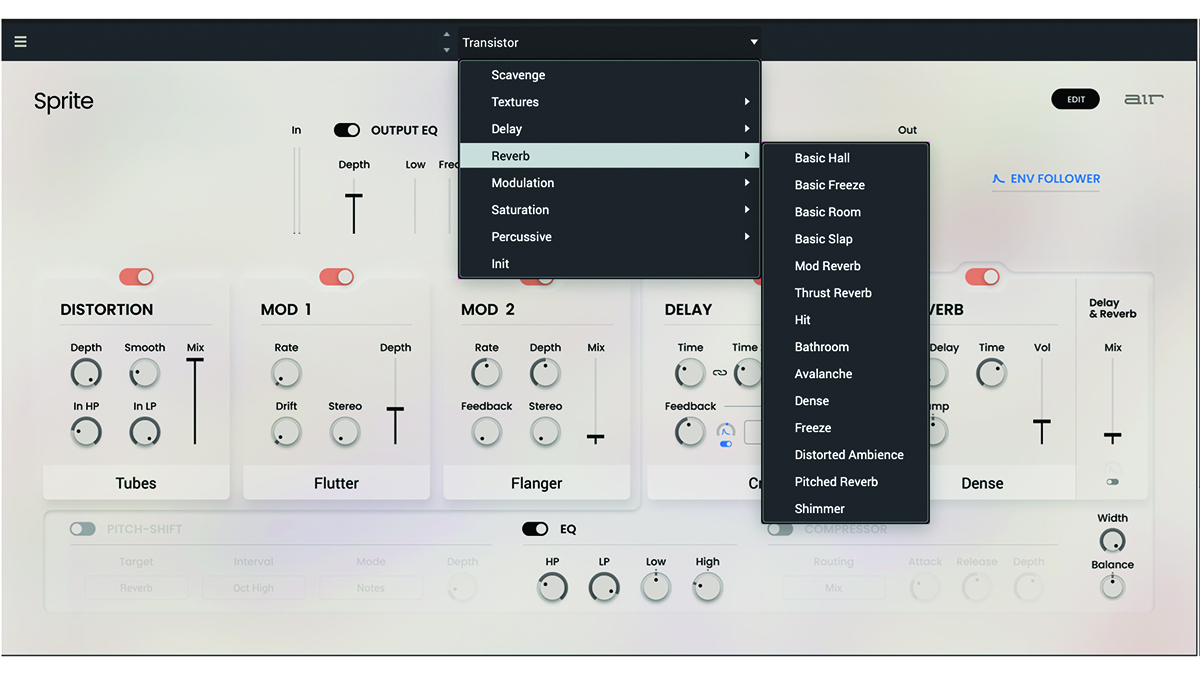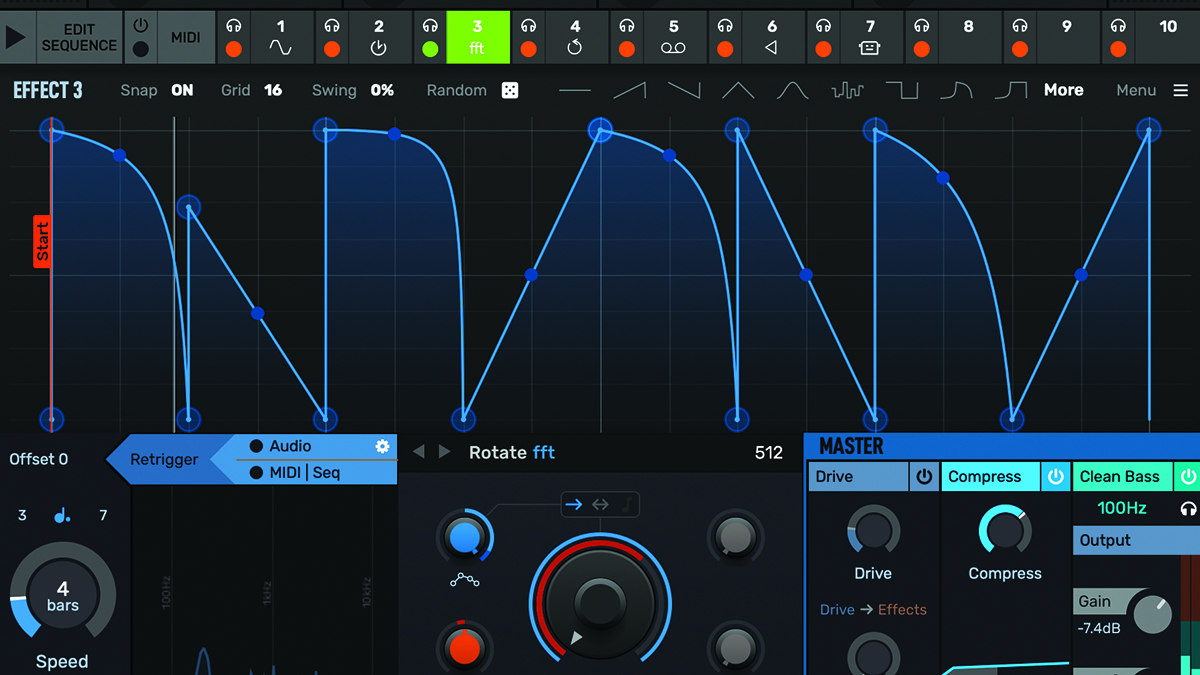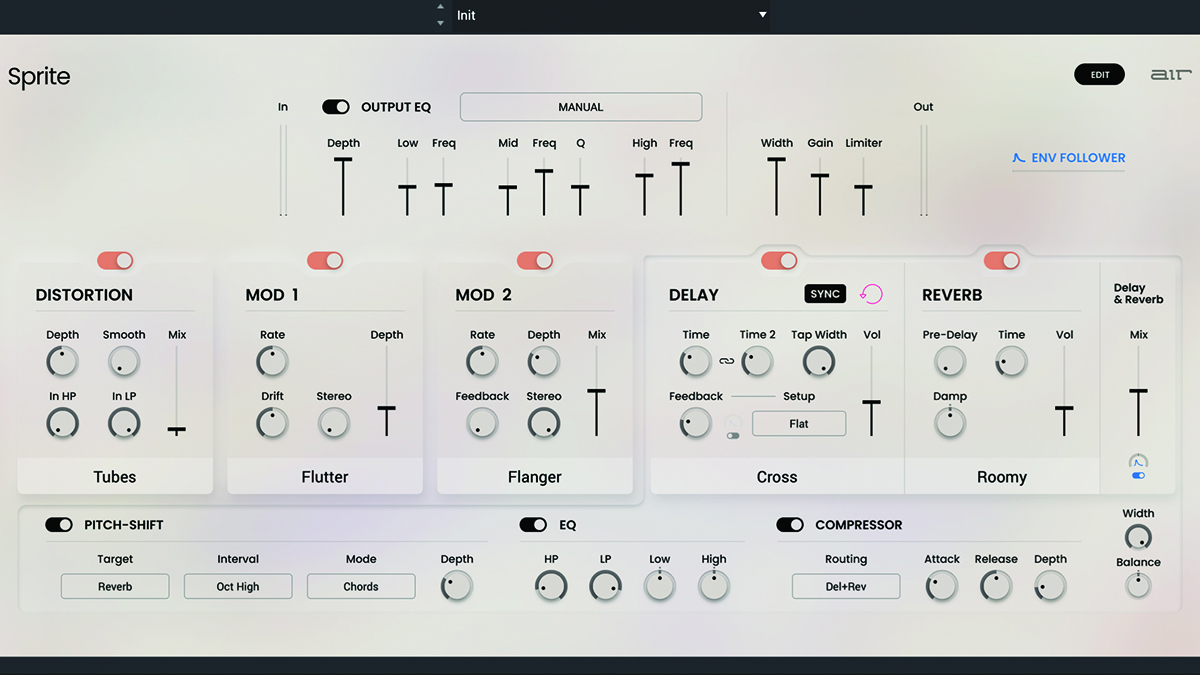
AIR Music Technology Sprite: What is it?
Recent plugin effects are certainly breaking the mould in terms of how they look and sound. Many newer titles from the likes of Baby Audio, Sound Device Digital, oeksound and Sonora Cinematic, all unconstrained by being based on vintage effects boxes, are starting to look much more welcoming. And, they are even ditching standard names for effect parameters in favour of more descriptive controls.
AIR Music Technology’s Sprite aims to go one further, its lush and simple UI giving you instant access to powerful effects engines with just a dozen or so controls on hand to get the best from them.

AIR Music Technology Sprite: Performance and verdict
Sprite is all about those five main controls in Performance mode that essentially give you access to five different effects as well as their amounts and mix levels.

• Devious Machines Infiltrator 2
One of the best multi-effects out there, Infiltrator 2 has 54 different modules but is way more complex.
• Eventide H3000 Factory
AIR based Sprite on multi-effects like the H3000, but here’s a proper virtual version… for more cash.
You go from left to right with Distortion, two modulation rotaries, Delay and Reverb. Simple sliders on the left and right of each access the two most important parameters for each, so with the modulation effects you control both Rate (left) and Depth (right). With Reverb, it’s Time (left) and Volume (right), and so on. You can (and should) just use Sprite on this level and this level alone, as that’s really the plugin’s USP: using these five effects in series to quickly and easily create varied effects. You can even bypass each one to reduce this number, although we couldn’t find an easy way to bypass all of them at once.
Better still, use the many presets to dial in very different sounds. And really this is Sprite in a nutshell: instant effects with big controls to shape them fast. But actually there are a lot of hidden extras should you wish to dive in.
First up, each effect has a drop-down menu of different types to dial in. Distortion has nine different types (Amp Classic, Amp Heavy, Tubes, Transformer, Vinyl, Speaker, Diodes, Synth and Digital); Mod 1 and 2 have eight types with four in each (Flutter, Wow, Tremolo, Auto-Pan, Chorus, Multi-Chorus, Phaser and Flanger); Delay has three (Single, Dual and Cross); and finally Reverb has eight (Dense, Gritty, Loose, Roomy, Boxy, Cramped, Tiny and Nano).
Some of these work well – we know where we are with the Mod ones – but losing the traditional descriptors doesn’t do the reverbs in particular any favours, often we weren’t quite sure where we were.
Still, open up the Edit mode page in Sprite and you get a host of more traditional parameters to alter for each effect, and this is where the real action is, should you wish to hone the effect.

The Edit screen
The Edit mode replicates the main UI controls but adds many more options for everything. The Distortion module, for example, adds hi- and lo-pass filtering and a control to smooth out the input signal; both Modulation modules add Stereo Width and either Drift (applied to mod rate) or Feedback (the signal fed back in line) to the Rate and Depth options you get in Performance mode. The Delay section is particularly impressive as it includes a 3-mode syncable engine, no less than 24 different feedback setups, Auto Clear to stop too much delay build-up and a fantastic envelope follower to control feedback based on input level.
Edit mode also includes extra global options that can apply extra EQ tweaking to the output signal plus Gain and Limiter options. There are pitchshifting and compressor sections and the delay/reverb sections can have processing applied to them alone – an impressive set of extras to try out.
Obey your thirst
But as much as we hate to say it, we think Sprite is more about the presets, and while we always urge you to get involved and create your own sounds on both synths, instruments and effects, Sprite almost guides you to start with the presets and tweak from there, which is actually no bad thing.
Sprite almost guides you into starting with the presets and tweaking from there, which is no bad thing
We’d suggest loading in a percussive loop to get a feel for Sprite and its enormous potential for sound design. Beats are especially at home with the syncable delay here and it’s great to lock this in and then change, say, the distortions to hear how filthy the plugin can go. Honestly you can make great changes just using the front panel dials, but the presets really do show you how deep and wild Sprite can go.
While Sprite is limited in some respects – you can’t change the effect order, for example – it is arguably these limitations that make it so instant and hands on. You won’t be wrestling with options to tweak, because unless you delve into the Edit mode, there aren’t that many. And this means you’ll get on with the job in hand: “That preset sounds great on that sound, so move on!”. And that kind of workflow – which Sprite really does encourage – is what constructive and inspirational music making is all about. It’s a pretty great price for what you get too, so highly recommended for instant effect action.
MusicRadar verdict: Sprite might not look that complex, but that is its strength. What’s more, it really can be as varied as you wish it to be; just dial in, tweak, mix and move on.
AIR Music Technology Sprite: The web says
"The effect types might seem very familiar, but the combination of options here can produce some very complex and appealing results that sound more sophisticated than you might expect — very much a case of the end result sounding greater than the sum of the parts."
Sound On Sound
AIR Music Technology Sprite: Hands-on demos
AIR Music Tech
Audio Tech TV
Musician Paradise
AIR Music Technology Sprite: Specifications
- macOS 11.7 Big Sur - macOS 13.2 Ventura (ARM compatible). 2GB free disk space. 4GB RAM (8GB recommended). Dual-core 2.5GHz CPU. VST 2/3 Plugin compatible host. AAX plugin compatible host. AU plugin compatible host.
- Windows 10 (22H2) - Windows 11 (22H2). 2GB free disk space. 4GB RAM (8GB recommended). Dual-core 2.5GHz CPU. VST 2/3 compatible host. AAX plugin compatible host.
- CONTACT: AIR Music Technology







